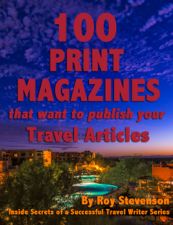- Home
- Business Basics for Travel Writers
- The Travel Writing Life
My Travel Writing Life
in the Office and Online
By Roy Stevenson
 I always spend time writing or pitching, even when I'm on the road.
I always spend time writing or pitching, even when I'm on the road.I'm always fielding questions about my travel writing life and how I spend my time, in and out of the office. Here's a question from an aspiring travel writer:
“Roy, I’m just curious to know - how much time per week do you spend sending out queries versus time spent on actual writing and on social media?
If you haven't already done an article on time management for writers, that might be a helpful story.”
I’m a big believer in keeping steady and regular hours for my freelance writing business. In terms of my travel writing life, I think that’s the only way to be successful.
When I started writing full-time in 2007, most of my time in the office was spent on marketing. Specifically, I researched story ideas, wrote query letters, prepared magazine lists and then sent my queries out.
I did this for at least 4-6 hours/day, usually 7 days/week.
The remainder of my time was spent writing commissioned articles and sending them off to editors. I spent about 3-4 hours/day on writing, depending on my backlog.
Over time I became far more efficient at researching and writing my query letters. So writing query letters took less time.
These days I only spend about 1-2 hours each day on marketing. That’s because I’ve established a solid stable of regular magazines, so pitching is not nearly as time consuming.
I write at least 3-4 hours each day. I balance this between writing articles for print and online media, and writing posts for my PitchTravelWrite website.
In general, I aim for a word count of 1,000-1,500 words/day.
If I’m inspired, and all jacked up on caffeine, I might process 2,000 words/day, but that would be exceptional.
My travel writing life includes spending time on social media. When I was starting out I didn't spend any time with this, and I was far too busy pitching story ideas. Times have changed.
Speaking from personal experience social media is NOT an effective way to round up magazine assignments. I did not use social media to round up any assignments back then, and I still don’t use it for this purpose.
A couple of years ago I surveyed a group of editors that I was working with and asked if they ever looked for writers using social media. They told me this was not their normal way of doing business. They rarely search for writers using social media.
If you want to interact with editors, do it with a good old-fashioned query letter sent to their email Inbox. Send them a sparkling story idea and see if they bite.
These days my travel writing life includes spending time on social media, in particular Facebook, but I use it for a different purpose. For me, social media is a highly effective way of finding aspiring travel writers interested in reading my weekly newsletter and the articles I write on PitchTravelWrite.com.
I spend up to 1-2 hours/day on social media connecting with my “travel writing” audience and sharing interesting posts with them.
I urge travel writers to proceed with great caution in the minefield of social media. Contrary to what many people believe, social media will not get you more than the occasional, sporadic assignment from editors.
For example, I’m a well-published writer with more than 1000 bylines in a wide variety of genres, a great writer’s website, and a strong Internet presence. Yet, I still only receive random story requests from editors 2-3 times/year. They found me on the internet, but they didn’t find me through social media.
I’m not dismissing social media from the writer’s toolbox. It’s just a poor way to make contact with magazine editors. They still prefer well-written query letters with good, old-fashioned pitches.
Anyone can puff themselves up on a website or Facebook or LinkedIn to look like a good writer. But selling your story really comes down to presenting an enticing story idea in a dazzling query letter that resonates with the editor. There’s no shortcut or easy social media “fix” to this.
Your Travel Writing Life & Social Media
Here's my advice for incorporating social media into your travel writing life.
For a basic internet presence, set up a professional writer’s website, a Facebook page (or your preferred social media platform), and list yourself on LinkedIn as a travel writer.
Then get on with pitching your travel stories directly to editors.
Social media is fun and you can spend as much time as you want using it. But it can kill your time. As a new writer, your time is far better spent building your bylines and getting published in a wide variety of magazines and travel websites.
And when you get an article published - you’ll have something to brag about to your friends on social media!
More on Managing Your Time & Social Media
Take control of your time: 7 Ways to Increase Productivity for Travel Writers
5 Tips to Increase Productivity gives you some ideas about how to manage your work and do things faster (without impacting quality).
And I wrote an article for travel writers answering the question “Will Social Media Help You Get Published?”
You can see all my travel writing craft topics here …
Do you want to learn about travel writing sales and
marketing techniques that work?
This manual has every tool and technique that I use to pitch and sell - and then resell - my travel stories. I hold nothing back. Reading this manual is like looking inside my marketing brain.

Roy Stevenson is a professional travel writer and the author of www.PitchTravelWrite.com. Over the past ten years, he’s had more than 1000 articles published in 200 magazines, trade and specialty journals, in-flights, on-boards, blogs and websites and has traveled on assignment around the U.S. and to dozens of international destinations.
IF YOU ENJOYED THIS POST, GET UPDATES. IT'S FREE.














